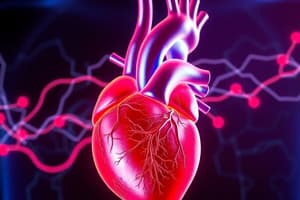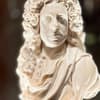Podcast
Questions and Answers
Which statement accurately describes the relationship between the pulmonary and systemic circuits?
Which statement accurately describes the relationship between the pulmonary and systemic circuits?
- The pulmonary circuit oxygenates blood in the lungs, and the systemic circuit distributes oxygenated blood to the body's tissues. (correct)
- The systemic circuit supplies blood to the heart muscle, while the pulmonary circuit supplies blood to the rest of the body.
- The pulmonary and systemic circuits operate in parallel, with blood flowing simultaneously through both.
- The pulmonary circuit carries oxygenated blood to the body, while the systemic circuit carries deoxygenated blood to the lungs.
The left atrium receives oxygenated blood directly from the systemic circuit.
The left atrium receives oxygenated blood directly from the systemic circuit.
False (B)
What is the primary function of the pericardium?
What is the primary function of the pericardium?
protect and anchor the heart
The ______ valve prevents the backflow of blood from the right ventricle into the right atrium.
The ______ valve prevents the backflow of blood from the right ventricle into the right atrium.
Match each heart valve with its correct location and function.
Match each heart valve with its correct location and function.
Which layer of the heart wall is responsible for the heart's contractile pumping action?
Which layer of the heart wall is responsible for the heart's contractile pumping action?
The semilunar valves prevent blood from flowing back into the ventricles from the aorta and pulmonary artery.
The semilunar valves prevent blood from flowing back into the ventricles from the aorta and pulmonary artery.
What is the clinical significance of the coronary circulation?
What is the clinical significance of the coronary circulation?
Angina pectoris is most often caused by ______ of coronary arterial circulation.
Angina pectoris is most often caused by ______ of coronary arterial circulation.
Match the type of blood vessel with its function.
Match the type of blood vessel with its function.
Which event triggers the opening of the atrioventricular (AV) valves?
Which event triggers the opening of the atrioventricular (AV) valves?
Scar tissue formed after a myocardial infarction is contractile, helping to maintain normal heart function.
Scar tissue formed after a myocardial infarction is contractile, helping to maintain normal heart function.
What is the role of the chordae tendineae and papillary muscles in the function of the atrioventricular valves?
What is the role of the chordae tendineae and papillary muscles in the function of the atrioventricular valves?
The ______ is a sudden coronary blockage leading to cell death.
The ______ is a sudden coronary blockage leading to cell death.
The coronary arteries arise from the:
The coronary arteries arise from the:
Flashcards
Pulmonary Circuit
Pulmonary Circuit
Carries blood to and from the lungs.
Systemic Circuit
Systemic Circuit
Carries blood to the tissues.
Arteries
Arteries
Carry blood away from the heart
Veins
Veins
Signup and view all the flashcards
Atria
Atria
Signup and view all the flashcards
Ventricles
Ventricles
Signup and view all the flashcards
Pericardium
Pericardium
Signup and view all the flashcards
Myocardium
Myocardium
Signup and view all the flashcards
Heart Valves
Heart Valves
Signup and view all the flashcards
Atrioventricular (AV) Valves
Atrioventricular (AV) Valves
Signup and view all the flashcards
Tricuspid Valve
Tricuspid Valve
Signup and view all the flashcards
Bicuspid/Mitral Valve
Bicuspid/Mitral Valve
Signup and view all the flashcards
Semilunar (SL) Valves
Semilunar (SL) Valves
Signup and view all the flashcards
Coronary Circulation
Coronary Circulation
Signup and view all the flashcards
Coronary Arteries
Coronary Arteries
Signup and view all the flashcards
Study Notes
Pulmonary & Systemic Circuits
- Pulmonary circuit carries blood to and from the lungs
- Systemic circuit carries blood to the tissues
- Arteries carry blood away from the heart
- Veins carry blood toward the heart
Heart Design
- Heart is a three-dimensional hollow mass of muscle
- Atria are the two receiving chambers
- The left atrium receives blood returning from the pulmonary circuit
- The right atrium receives blood returning from the systemic circuit
- Ventricles are the two pumping chambers
- The right ventricle pumps blood into the pulmonary circuit
- The left ventricle pumps blood into the systemic circuit
Heart Anatomy
- The heart is enclosed in a fluid-filled sac
- This fluid-filled sac protects and anchors the heart
- The heart wall includes the epicardium
- The heart wall includes the myocardium
- The heart wall includes the endocardium
Heart Valves
- Atrioventricular (AV) valves ensure unidirectional blood flow
- AV valves are located at each atrial-ventricular junction
- AV valve located between the right atria and right ventricle
- AV valve located between the left atria and left ventricle
- AV valves prevent backflow of blood into the atria when the ventricles contract
Semilunar Valves
- Semilunar (SL) valves also ensure unidirectional blood flow
- SL valves are located at each ventricle/artery connection
- One SL valve separates the right ventricle and pulmonary arteries
- One SL valve separates the left ventricle and aorta
- SL valves prevent backflow of blood into the ventricle
Coronary Circulation
- Coronary circulation provides blood supply to the heart muscle (myocardium)
- The coronary arteries arise from the base of the aorta
- Venous blood empties into the right atrium
Coronary Disease
- Angina pectoris is caused by a blockage of coronary arterial circulation that causes a fleeting halt in blood delivery
- Myocardial infarction is due to coronary blockage
- Myocardial infarction causes cell death
- Scar tissue formed from myocardial infarction is non-contractile
Studying That Suits You
Use AI to generate personalized quizzes and flashcards to suit your learning preferences.




